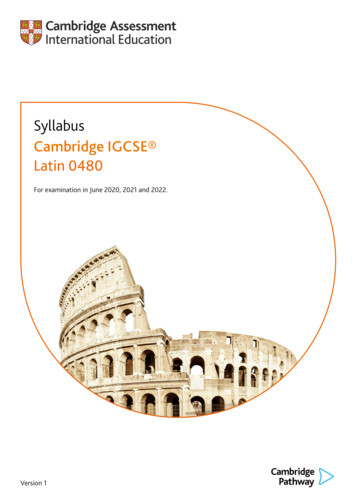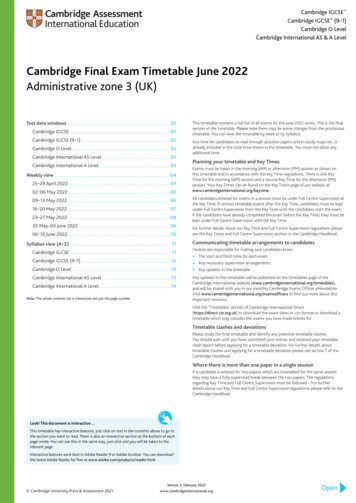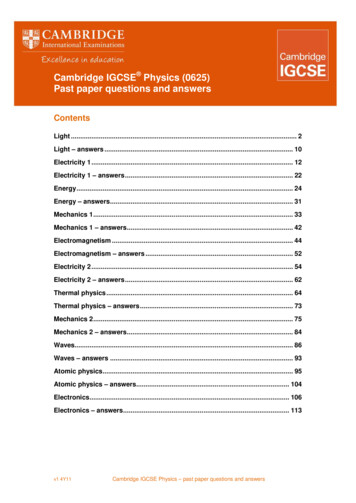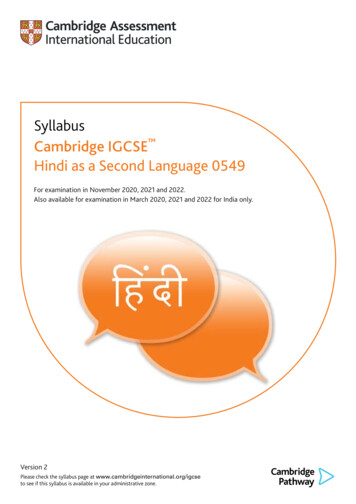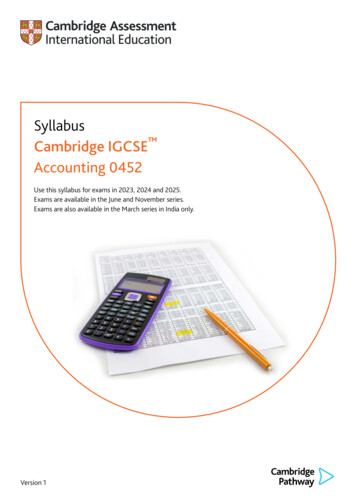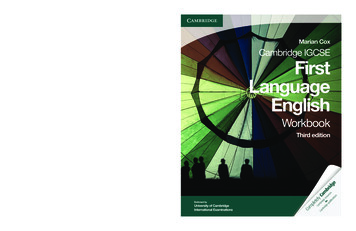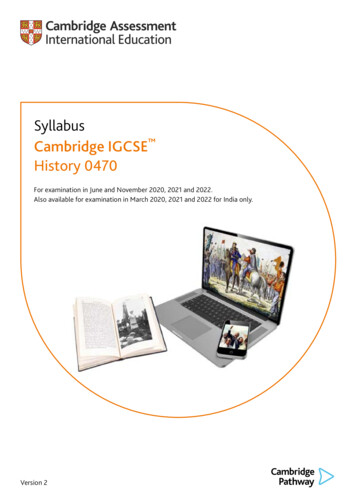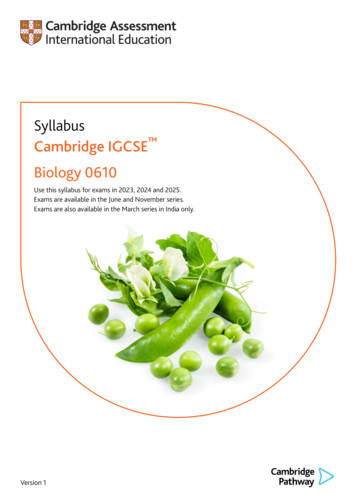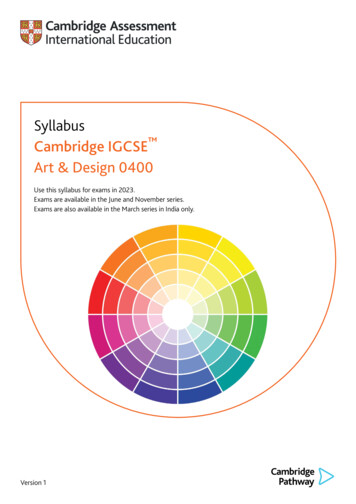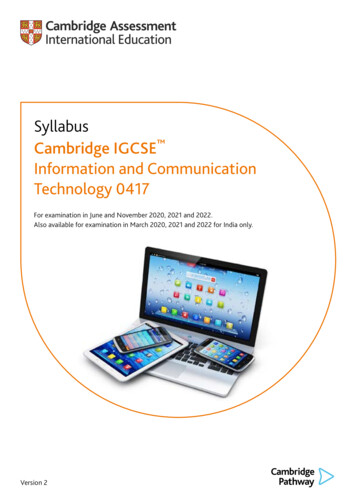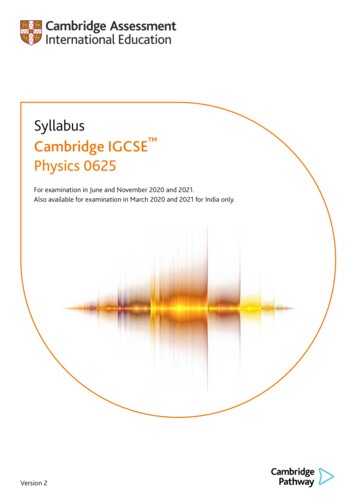
Transcription
SyllabusCambridge IGCSE Physics 0625For examination in June and November 2020 and 2021.Also available for examination in March 2020 and 2021 for India only.Version 2
Why choose Cambridge?Cambridge Assessment International Education prepares school students for life, helping them develop an informedcuriosity and a lasting passion for learning. We are part of the University of Cambridge.Our international qualifications are recognised by the world’s best universities and employers, giving students awide range of options in their education and career. As a not-for-profit organisation, we devote our resources todelivering high-quality educational programmes that can unlock learners’ potential.Our programmes and qualifications set the global standard for international education. They are created by subjectexperts, rooted in academic rigour and reflect the latest educational research. They provide a strong platform forlearners to progress from one stage to the next, and are well supported by teaching and learning resources.Our mission is to provide educational benefit through provision of international programmes and qualifications forschool education and to be the world leader in this field. Together with schools, we develop Cambridge learnerswho are confident, responsible, reflective, innovative and engaged – equipped for success in the modern world.Every year, nearly a million Cambridge students from 10 000 schools in 160 countries prepare for their future withan international education from Cambridge International.‘We think the Cambridge curriculum is superb preparation for university.’Christoph Guttentag, Dean of Undergraduate Admissions, Duke University, USAQuality managementOur systems for managing the provision of international qualifications and education programmesfor students aged 5 to 19 are certified as meeting the internationally recognised standard forquality management, ISO 9001:2008. Learn more at www.cambridgeinternational.org/ISO9001Cambridge Assessment International Education is part of the Cambridge Assessment Group. Cambridge Assessment is the brand name ofthe University of Cambridge Local Examinations Syndicate (UCLES), which itself is a department of the University of Cambridge.UCLES retains the copyright on all its publications. Registered centres are permitted to copy material from this booklet for their owninternal use. However, we cannot give permission to centres to photocopy any material that is acknowledged to a third party even forinternal use within a centre.
Contents1 Why choose this syllabus? . 22 Syllabus overview .4Aims4Content overview5Assessment overview6Assessment objectives73 Subject content .94 Details of the assessment .27Core Assessment27Extended Assessment27Practical Assessment28Glossary of terms used in science papers315 Appendix.32Electrical symbols32Symbols and units for physical quantities34Safety in the laboratory36Mathematical requirements37Presentation of data38ICT opportunities39Conventions (e.g. signs, symbols, terminology and nomenclature)396 What else you need to know . 40Before you start40Making entries41After the exam42How students and teachers can use the grades42Grade descriptions42Changes to this syllabus for 2020 and 202143Changes to this syllabusFor information about changes to this syllabus for 2020 and 2021, go to page 43.The latest syllabus is version 2, published December 2018. There are no significant changes which affectteaching.Any textbooks endorsed to support the syllabus for examination from 2016 are still suitable for use with thissyllabus.
Cambridge IGCSE Physics 0625 syllabus for 2020 and 2021.1 Why choose this syllabus?Key benefitsCambridge IGCSE syllabuses are created especially for international students. For over 25 years, we have workedwith schools and teachers worldwide to develop syllabuses that are suitable for different countries, different typesof schools and for learners with a wide range of abilities.Cambridge IGCSE Physics enables learners to: increase their understanding of the technological world take an informed interest in scientific matters recognise the usefulness (and limitations) of scientific method, and how to apply this to other disciplines and ineveryday life develop relevant attitudes, such as a concern for accuracy and precision, objectivity, integrity, enquiry, initiativeand inventiveness develop an interest in, and care for, the environment better understand the influence and limitations placed on scientific study by society, economy, technology,ethics, the community and the environment develop an understanding of the scientific skills essential for both further study and everyday life.Our programmes balance a thorough knowledge and understanding of a subject and help to develop the skillslearners need for their next steps in education or employment.Our approach encourages learners to be:Cambridgelearner‘The strength of Cambridge IGCSE qualifications is internationally recognised and has providedan international pathway for our students to continue their studies around the world.’Gary Tan, Head of Schools and CEO, Raffles International Group of Schools, Indonesia2www.cambridgeinternational.org/igcseBack to contents page
Cambridge IGCSE Physics 0625 syllabus for 2020 and 2021. Why choose this syllabus?Recognition and progressionThe combination of knowledge and skills in Cambridge IGCSE Physics gives learners a solid foundation for furtherstudy. Candidates who achieve grades A* to C are well prepared to follow a wide range of courses includingCambridge International AS & A Level Physics.Cambridge IGCSEs are accepted and valued by leading universities and employers around the world as evidence ofacademic achievement. Many universities require a combination of Cambridge International AS & A Levels andCambridge IGCSEs or equivalent to meet their entry requirements.UK NARIC, the national agency in the UK for the recognition and comparison of international qualifications andskills, has carried out an independent benchmarking study of Cambridge IGCSE and found it to be comparable tothe standard of GCSE in the UK. This means students can be confident that their Cambridge IGCSE qualificationsare accepted as equivalent to UK GCSEs by leading universities worldwide.Learn more at ng teachersWe provide a wide range of practical resources, detailed guidance, and innovative training and professionaldevelopment so that you can give your learners the best possible preparation for Cambridge IGCSE.Teaching resourcesExam preparation resources School Support Hubwww.cambridgeinternational.org/support Question papers Syllabus Scheme of work Example candidate responses to understandwhat examiners are looking for at key grades Learner guide Examiner reports to improve future teaching Mark schemes Discussion forum Resource list Endorsed textbooks and digital resourcesTrainingSupport forCambridgeIGCSE Face-to-face workshops around the world Online self-study training Online tutor-led training Cambridge Professional DevelopmentQualificationsCommunityYou can find useful information, as well asshare your ideas and experiences with otherteachers, on our social media channels andcommunity forums.Find out more mbridge IGCSE is one of the most sought-after and recognised qualifications in the world. Itis very popular in Egypt because it provides the perfect preparation for success at advanced levelprogrammes.’Mrs Omnia Kassabgy, Managing Director of British School in Egypt BSEBack to contents pagewww.cambridgeinternational.org/igcse3
Cambridge IGCSE Physics 0625 syllabus for 2020 and 2021.2 Syllabus overviewAimsThe aims describe the purposes of a course based on this syllabus.You can deliver some of the aims using suitable local, international or historical examples and applications, orthrough collaborative experimental work.The aims are to: provide an enjoyable and worthwhile educational experience for all learners, whether or not they go on tostudy science beyond this level enable learners to acquire sufficient knowledge and understanding to:–– become confident citizens in a technological world and develop an informed interest in scientific matters–– be suitably prepared for studies beyond Cambridge IGCSE allow learners to recognise that science is evidence based and understand the usefulness, and the limitations, ofscientific method develop skills that:–– are relevant to the study and practice of physics–– are useful in everyday life–– encourage a systematic approach to problem solving–– encourage efficient and safe practice–– encourage effective communication through the language of science develop attitudes relevant to physics such as:–– concern for accuracy and precision–– objectivity–– integrity–– enquiry–– initiative–– inventiveness enable learners to appreciate that:–– science is subject to social, economic, technological, ethical and cultural influences and limitations–– the applications of science may be both beneficial and detrimental to the individual, the community andthe ack to contents page
Cambridge IGCSE Physics 0625 syllabus for 2020 and 2021. Syllabus overviewContent overviewCandidates study the following topics:1General physics2Thermal physics3Properties of waves, including light and sound4Electricity and magnetism5Atomic physicsSupport for Cambridge IGCSE PhysicsOur School Support Hub www.cambridgeinternational.org/support provides Cambridge schools with asecure site for downloading specimen and past question papers, mark schemes, grade thresholds and othercurriculum resources specific to this syllabus. The School Support Hub community offers teachers theopportunity to connect with each other and to ask questions related to the syllabus.Back to contents pagewww.cambridgeinternational.org/igcse5
Cambridge IGCSE Physics 0625 syllabus for 2020 and 2021. Syllabus overviewAssessment overviewAll candidates take three papers.Candidates who have studied the Core subject content, or who are expected to achieve a grade D or below, shouldbe entered for Paper 1, Paper 3 and either Paper 5 or Paper 6. These candidates will be eligible for grades C to G.Candidates who have studied the Extended subject content (Core and Supplement), and who are expected toachieve a grade C or above, should be entered for Paper 2, Paper 4 and either Paper 5 or Paper 6. These candidateswill be eligible for grades A* to G.Core candidates take:Extended candidates take:Paper 1Multiple ChoicePaper 2Multiple Choice45 minutes30%40 marks40 marks40 four-choice multiple-choice questions40 four-choice multiple-choice questionsQuestions will be based on the Core subjectcontentQuestions will be based on the Extendedsubject content (Core and Supplement)Externally assessedExternally assessedand Core candidates take:and Extended candidates take:Paper 3Theory1 hour 15 minutes50%Paper 4Theory1 hour 15 minutes50%80 marks80 marksShort-answer and structured questionsShort-answer and structured questionsQuestions will be based on the Core subjectcontentQuestions will be based on the Extendedsubject content (Core and Supplement)Externally assessedExternally assessedAll candidates takeeither:or:Paper 5Practical Test645 minutes30%1 hour 15 minutes20%Paper 6Alternative to Practical1 hour20%40 marks40 marksQuestions will be based on the experimentalskills in Section 4Questions will be based on the experimentalskills in Section 4Externally assessedExternally assessedwww.cambridgeinternational.org/igcseBack to contents page
Cambridge IGCSE Physics 0625 syllabus for 2020 and 2021. Syllabus overviewAssessment objectivesThe assessment objectives (AOs) are:AO1 Knowledge with understandingCandidates should be able to demonstrate knowledge and understanding of: scientific phenomena, facts, laws, definitions, concepts and theories scientific vocabulary, terminology and conventions (including symbols, quantities and units) scientific instruments and apparatus, including techniques of operation and aspects of safety scientific and technological applications with their social, economic and environmental implications.Subject content defines the factual material that candidates may be required to recall and explain. Candidates willalso be asked questions which require them to apply this material to unfamiliar contexts and to apply knowledgefrom one area of the syllabus to another.Questions testing this objective will often begin with one of the following words: define, state, describe, explain(using your knowledge and understanding) or outline (see the Glossary of terms used in science papers).AO2 Handling information and problem solvingCandidates should be able, in words or using other written forms of presentation (i.e. symbolic, graphical andnumerical), to: locate, select, organise and present information from a variety of sources translate information from one form to another manipulate numerical and other data use information to identify patterns, report trends and draw inferences present reasoned explanations for phenomena, patterns and relationships make predictions and hypotheses solve problems, including some of a quantitative nature.Questions testing these skills may be based on information that is unfamiliar to candidates, requiring them to applythe principles and concepts from the syllabus to a new situation, in a logical, deductive way.Questions testing these skills will often begin with one of the following words: predict, suggest, calculate ordetermine (see the Glossary of terms used in science papers).AO3 Experimental skills and investigationCandidates should be able to: demonstrate knowledge of how to safely use techniques, apparatus and materials (including following asequence of instructions where appropriate) plan experiments and investigations make and record observations, measurements and estimates interpret and evaluate experimental observations and data evaluate methods and suggest possible improvements.Back to contents pagewww.cambridgeinternational.org/igcse7
Cambridge IGCSE Physics 0625 syllabus for 2020 and 2021. Syllabus overviewWeighting for assessment objectivesThe approximate weightings allocated to each of the assessment objectives (AOs) are summarised below.Assessment objectives as a percentage of the qualificationAssessment objectiveWeighting in IGCSE %AO1 Knowledge with understanding50AO2 Handling information and problem solving30AO3 Experimental skills and investigations20Assessment objectives as a percentage of each componentAssessment objective8Weighting in components %Papers 1and 2Papers 3and 4Papers 5and 6AO1 Knowledge with understanding63630AO2 Handling information and problem solving37370AO3 Experimental skills and igcseBack to contents page
Cambridge IGCSE Physics 0625 syllabus for 2020 and 2021.3 Subject contentAll candidates should be taught the Core subject content. Candidates who are only taught the Core subject contentcan achieve a maximum of grade C. Candidates aiming for grades A* to C should be taught the Extended subjectcontent. The Extended subject content includes both the Core and the Supplement.Scientific subjects are, by their nature, experimental. Learners should pursue a fully integrated course which allowsthem to develop their practical skills by carrying out practical work and investigations within all of the topics listed.1General physics1.1Length and timeCoreSupplement Use and describe the use of rules and measuringcylinders to find a length or a volume Understand that a micrometer screw gauge isused to measure very small distances Use and describe the use of clocks and devices,both analogue and digital, for measuring aninterval of time Obtain an average value for a small distanceand for a short interval of time by measuringmultiples (including the period of a pendulum)1.2MotionCoreSupplement Define speed and calculate averagetotal distancespeed fromtotal time Plot and interpret a speed–time graph or adistance–time graph Distinguish between speed and velocity Recognise from the shape of a speed–time graphwhen a body is–– at rest–– moving with constant speed–– moving with changing speed Calculate the area under a speed–time graph towork out the distance travelled for motion withconstant acceleration Demonstrate understanding that accelerationand deceleration are related to changing speedincluding qualitative analysis of the gradient of aspeed–time graph State that the acceleration of free fall for a bodynear to the Earth is constantBack to contents page Define and calculate acceleration usingchange of velocitytime taken Calculate speed from the gradient of adistance–time graph Calculate acceleration from the gradient of aspeed–time graph Recognise linear motion for which theacceleration is constant Recognise motion for which the acceleration isnot constant Understand deceleration as a negativeacceleration Describe qualitatively the motion of bodiesfalling in a uniform gravitational field with andwithout air resistance (including reference toterminal velocity)www.cambridgeinternational.org/igcse9
Cambridge IGCSE Physics 0625 syllabus for 2020 and 2021. Subject content1.3Mass and weightCoreSupplement Show familiarity with the idea of the mass of abody Demonstrate an understanding that mass is aproperty that ‘resists’ change in motion State that weight is a gravitational force Describe, and use the concept of, weight as theeffect of a gravitational field on a mass Distinguish between mass and weight Recall and use the equation W mg Demonstrate understanding that weights (andhence masses) may be compared using a balance1.4DensityCore Recall and use the equation ρ mV Describe an experiment to determine the densityof a liquid and of a regularly shaped solid andmake the necessary calculation Describe the determination of the density ofan irregularly shaped solid by the method ofdisplacement Predict whether an object will float based ondensity data1.5Forces1.5.1 Effects of forcesCoreSupplement Recognise that a force may produce a change insize and shape of a body Plot and interpret extension–load graphs anddescribe the associated experimental procedure State Hooke’s Law and recall and use theexpression F k x, where k is the spring constant Recognise the significance of the ‘limit ofproportionality’ for an extension–load graph Describe the ways in which a force may changethe motion of a body Recall and use the relationship between force,mass and acceleration (including the direction),F ma Find the resultant of two or more forces actingalong the same line Describe qualitatively motion in a circular pathdue to a perpendicular force(F mv 2 / r is not required) Recognise that if there is no resultant force ona body it either remains at rest or continues atconstant speed in a straight line Understand friction as the force between twosurfaces which impedes motion and results inheating Recognise air resistance as a form of friction10www.cambridgeinternational.org/igcseBack to contents page
Cambridge IGCSE Physics 0625 syllabus for 2020 and 2021. Subject content1.5.2 Turning effectCoreSupplement Describe the moment of a force as a measure ofits turning effect and give everyday examples Understand that increasing force or distancefrom the pivot increases the moment of a force Calculate moment using the product force perpendicular distance from the pivot Apply the principle of moments to the balancingof a beam about a pivot Apply the principle of moments to differentsituations1.5.3 Conditions for equilibriumCoreSupplement Recognise that, when there is no resultant forceand no resultant turning effect, a system is inequilibrium Perform and describe an experiment (involvingvertical forces) to show that there is no netmoment on a body in equilibrium1.5.4 Centre of massCore Perform and describe an experiment todetermine the position of the centre of mass of aplane lamina Describe qualitatively the effect of the positionof the centre of mass on the stability of simpleobjects1.5.5 Scalars and vectorsSupplement Understand that vectors have a magnitude anddirection Demonstrate an understanding of the differencebetween scalars and vectors and give commonexamples Determine graphically the resultant of twovectorsBack to contents pagewww.cambridgeinternational.org/igcse11
Cambridge IGCSE Physics 0625 syllabus for 2020 and 2021. Subject content1.6MomentumSupplement Understand the concepts of momentum andimpulse Recall and use the equationmomentum mass velocity, p mv Recall and use the equation for impulseFt mv – mu Apply the principle of the conservation ofmomentum to solve simple problems in onedimension1.7Energy, work and power1.7.1 EnergyCoreSupplement Identify changes in kinetic, gravitationalpotential, chemical, elastic (strain), nuclear andinternal energy that have occurred as a result ofan event or process Recall and use the expressionskinetic energy ½mv 2 and change ingravitational potential energy mg h Recognise that energy is transferred duringevents and processes, including examples oftransfer by forces (mechanical working), byelectrical currents (electrical working), by heatingand by waves Apply the principle of conservation of energy tosimple examples Apply the principle of conservation of energy toexamples involving multiple stages Explain that in any event or process the energytends to become more spread out among theobjects and surroundings Back to contents page
Cambridge IGCSE Physics 0625 syllabus for 2020 and 2021. Subject content1.7.2 Energy resourcesCoreSupplement Describe how electricity or other useful forms ofenergy may be obtained from: Understand that the Sun is the source of energyfor all our energy resources except geothermal,nuclear and tidal–– chemical energy stored in fuel–– water, including the energy stored in waves,in tides, and in water behind hydroelectricdams Show an understanding that energy is released bynuclear fusion in the Sun–– geothermal resources–– nuclear fission–– heat and light from the Sun (solar cells andpanels)–– wind Give advantages and disadvantages of eachmethod in terms of renewability, cost, reliability,scale and environmental impact Show a qualitative understanding of efficiency Recall and use the equations:useful energy outputefficiency 100%energy inputefficiency useful power output 100%power input1.7.3 WorkCoreSupplement Demonstrate understanding thatwork done energy transferred Recall and use W Fd E Relate (without calculation) work done to themagnitude of a force and the distance moved inthe direction of the force1.7.4 PowerCoreSupplement R elate (without calculation) power to work doneand time taken, using appropriate examples Recall and use the equation P E / t in simplesystemsBack to contents pagewww.cambridgeinternational.org/igcse13
Cambridge IGCSE Physics 0625 syllabus for 2020 and 2021. Subject content1.8PressureSupplementCore Recall and use the equation p F / A Relate pressure to force and area, usingappropriate examples Describe the simple mercury barometer and itsuse in measuring atmospheric pressure Relate (without calculation) the pressure beneatha liquid surface to depth and to density, usingappropriate examples Recall and use the equation p hρg Use and describe the use of a manometer2Thermal physics2.1Simple kinetic molecular model of matter2.1.1 States of matterCore State the distinguishing properties of solids,liquids and gases2.1.2 Molecular modelCoreSupplement Describe qualitatively the molecular structureof solids, liquids and gases in terms of thearrangement, separation and motion of themolecules Relate the properties of solids, liquids and gasesto the forces and distances between moleculesand to the motion of the molecules Interpret the temperature of a gas in terms of themotion of its molecules Describe qualitatively the pressure of a gas interms of the motion of its molecules Show an understanding of the random motionof particles in a suspension as evidence for thekinetic molecular model of matter Explain pressure in terms of the change ofmomentum of the particles striking the wallscreating a force Show an appreciation that massive particles maybe moved by light, fast-moving molecules Describe this motion (sometimes known asBrownian motion) in terms of random molecularbombardment2.1.3 Evaporation14CoreSupplement Describe evaporation in terms of the escape ofmore-energetic molecules from the surface of aliquid Demonstrate an understanding of howtemperature, surface area and draught over asurface influence evaporation Relate evaporation to the consequent cooling ofthe liquid Explain the cooling of a body in contact with anevaporating liquidwww.cambridgeinternational.org/igcseBack to contents page
Cambridge IGCSE Physics 0625 syllabus for 2020 and 2021. Subject content2.1.4 Pressure changesCoreSupplement Describe qualitatively, in terms of molecules, theeffect on the pressure of a gas of: Recall and use the equationpV constant for a fixed mass of gasat constant temperature–– a change of temperature at constant volume–– a change of volume at constant temperature2.2Thermal properties and temperature2.2.1 Thermal expansion of solids, liquids and gasesCore Describe qualitatively the thermal expansion ofsolids, liquids, and gases at constant pressure Identify and explain some of the everydayapplications and consequences of thermalexpansionSupplement Explain, in terms of the motion and arrangementof molecules, the relative order of the magnitudeof the expansion of solids, liquids and gases2.2.2 Measurement of temperatureCoreSupplement Appreciate how a physical property thatvaries with temperature may be used forthe measurement of temperature, and stateexamples of such properties Demonstrate understanding of sensitivity, rangeand linearity Recognise the need for and identify fixed points Describe and explain the structure and action ofliquid-in-glass thermometers Describe the structure of a thermocouple andshow understanding of its use as a thermometerfor measuring high temperatures and those thatvary rapidly Describe and explain how the structure ofa liquid-in-glass thermometer relates to itssensitivity, range and linearity2.2.3 Thermal capacity (heat capacity)CoreSupplement Relate a rise in the temperature of a body to anincrease in its internal energy Give a simple molecular account of an increase ininternal energy Show an understanding of what is meant by thethermal capacity of a body Recall and use the equationthermal capacity mc Define specific heat capacity Describe an experiment to measure the specificheat capacity of a substance Recall and use the equationchange in energy mc TBack to contents pagewww.cambridgeinternational.org/igcse15
Cambridge IGCSE Physics 0625 syllabus for 2020 and 2021. Subject content2.2.4 Melting and boilingCoreSupplement Describe melting and boiling in terms of energyinput without a change in temperature Distinguish between boiling and evaporation State the meaning of melting point and boilingpoint Describe condensation and solidification in termsof molecules Use the terms latent heat of vaporisation andlatent heat of fusion and give a molecularinterpretation of latent heat Define specific latent heat Describe an experiment to measure specificlatent heats for steam and for ice Recall and use the equation energy ml2.3Thermal processes2.3.1 ConductionCoreSupplement Describe experiments to demonstrate theproperties of good and bad thermal conductors Give a simple molecular account of conduction insolids including lattice vibration and transfer byelectrons2.3.2 ConvectionCore Recognise convection as an important method ofthermal transfer in fluids Relate convection in fluids to density changesand describe experiments to illustrate convection2.3.3 RadiationCoreSupplement Identify infrared radiation as part of theelectromagnetic spectrum Describe experiments to show the propertiesof good and bad emitters and good and badabsorbers of infrared radiation Recognise that thermal energy transfer byradiation does not require a medium Describe the effect of surface colour (blackor white) and texture (dull or shiny) on theemission, absorption and reflection of radiation16www.cambridgeinternational.org/igcse Show understanding that the amount ofradiation emitted also depends on the surfacetemperature and surface area of a bodyBack to contents page
Cambridge IGCSE Physics 0625 syllabus for 2020 and 2021. Subject content2.3.4 Consequences of energy transferCore Identify and explain some of the everydayapplications and consequences of conduction,convection and radiation3Properties of waves, including light and sound3.1General wave propertiesSupplementCore Demonstrate understanding that waves transferenergy without transferring matter D
Cambridge IGCSE Physics 0625 syllabus for 2020 and 2021. Syllabus overview Back to contents page www.cambridgeinternational.orgigcse 5 Content overview Candidates study the following topics: 1 General physics 2 Thermal physics 3 Properties of waves, including light and sound 4 Electricity and magnetism 5 Atomic physics
